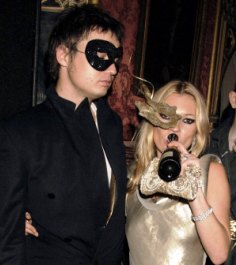Tags
Related Posts
Share This
Kate Moss: The invisible woman.
 Kate Moss is just sad old mutton masquerading as supermodel lamb. We know this because FHM , the female anatomy magazine, says so. At the time of writing, Moss was thousands of votes short of making their 100 Sexiest Women readers’ poll. FHM spokesman Chris Bell said: ‘In the fashion world, Kate is considered one of the most beautiful women, but according to FHM readers, she’s past it.’
Kate Moss is just sad old mutton masquerading as supermodel lamb. We know this because FHM , the female anatomy magazine, says so. At the time of writing, Moss was thousands of votes short of making their 100 Sexiest Women readers’ poll. FHM spokesman Chris Bell said: ‘In the fashion world, Kate is considered one of the most beautiful women, but according to FHM readers, she’s past it.’
Bell added that hanging out with Pete Doherty had left Moss ‘weathered’ and his readers preferred someone ‘more womanly’. Presumably someone like the FHM poll front runner, glamour model Keeley Hazell – a hottie blessed with the kind of chest a tragically confused Sir Ranulph Fiennes might one day attempt to climb. One imagines that it would be difficult to fill a small room with men who couldn’t find something about Hazell they liked. One imagines that the same room could be allocated to women who’d actually heard of her.
For Hazell is one of those ‘invisible ink’ women – as in, culturally invisible to one gender while visible with a (hormonally charged) vengeance to the other. The irony is noteworthy: when women all over the country are preparing to buy Moss’s clothes at Topshop, the males of the parish are losing interest in her taking them off. It seems bizarre that women opt for Moss as their Favourite-Ever Modernday Icon while the readers of a men’s magazine wouldn’t even place her in their top 100. Would it be too paranoid to put the whole thing down to their relative ages – the fact that Hazell is 20 (good), while Moss is 33 (bad)?
Don’t be stupid, say several male sources. As in, of course it isn’t too paranoid. One man said: ‘I’ve never heard of this Keeley, but I already fancy her from your description “20-year-old glamour model”.’ Another reminded me that, despite centuries of evolution and decades of equality, male loins remain strangers to feminism: ‘Testosterone tells no lies. Oestrogen may be more forgiving.’ Before I placed my head in the gas oven, there was just enough time to chat to another man, who gallantly proclaimed that Moss is beautiful but may have been around too long: ‘It gets a bit like fancying the Queen.’
In US literary sensation The Female Brain, scientist Louann Brizendine reaffirms that one of the ways men are different from women (apart from the fact that we talk too much, and they get aggressive too often) is that men have double the amount of interest in sexual pursuit, which colours their decision-making process. She recounts an experiment she conducted where women were given male-level doses of testosterone, and ‘their libidos exploded’.
The male brain makes its decisions through a murky haze of hormonally fuelled desire, while the female brain is often perfectly happy spending an afternoon eating custard creams looking at pictures of Kate in her Ugg boots. (All men getting grumpy about being stereotyped in this way should wait for Brizendine’s next work, The Male Brain , which she will presumably start as soon as she’s sourced enough paper for the pamphlet.)
One wonders if this is just another misogynistic Catch 22 – a woman may be beautiful but not young enough; young, but not beautiful enough. It could just be the Gender Beauty gap – that omnipresent blind spot whereby men often simply don’t ‘get’ the females that women like, and vice versa. There was a time where men and women could safely agree that, say, Ava Gardner was The Sexiest, Most Beautiful Woman on the Planet.
Now it’s not so simple. You get the rare cases such as Jordan straddling both camps – starting off as an exclusively male phenomenon, all breasts and thongs, then cleverly morphing into Katie Price, female survival icon. Sometimes you even get it the other way (Sienna Miller was once a Fashion Miss, now the FHM readers have grabbed her for their Sexiest poll). Ultimately it doesn’t make any difference. You’re always going to get men who have to have it slowly and painfully explained to them why Jennifer Aniston is interesting. The amazing thing is that now we have to explain Kate Moss to them, too. That’s the trouble with the female brain – it’s just not kept near enough to our trousers.







